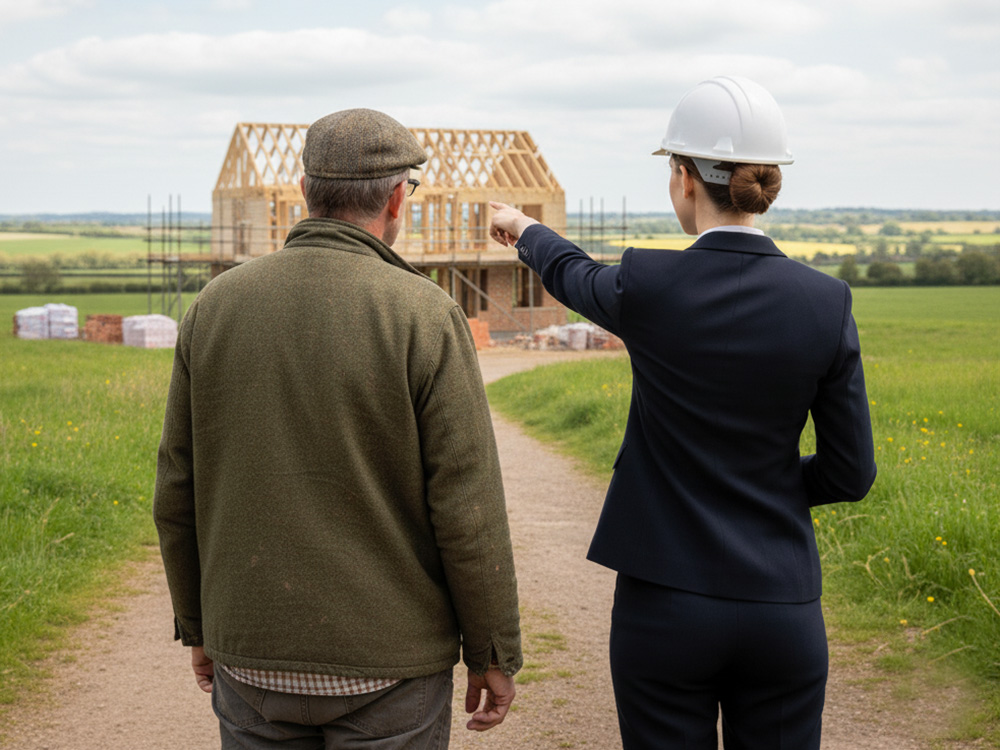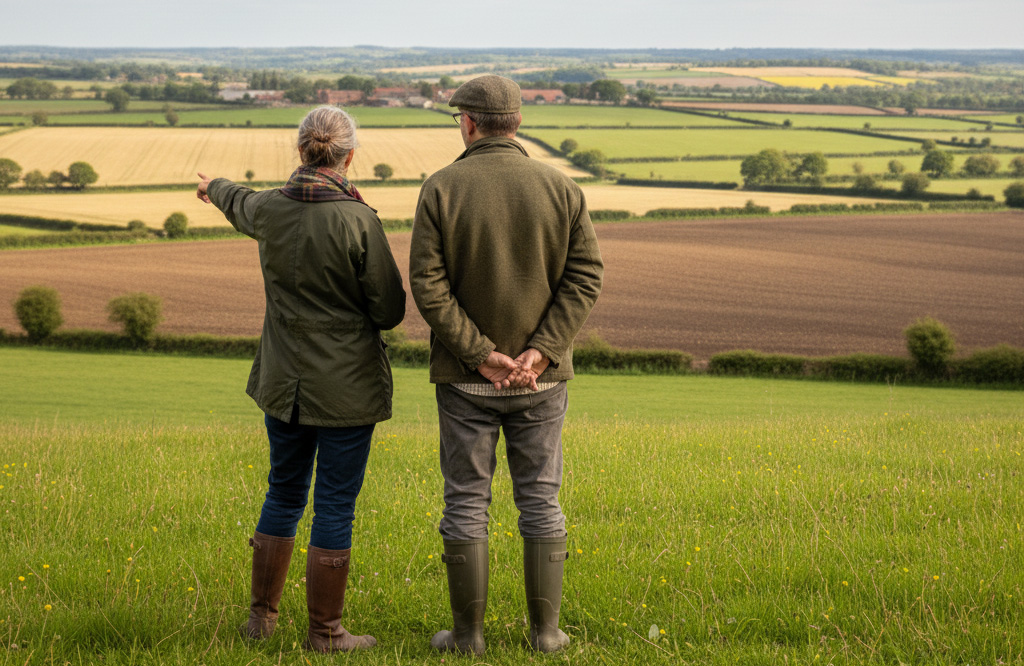When buyers, sellers, or investors ask, “what is the value of agricultural land per acre?”, they usually expect a neat figure. But the reality is more complex. While national averages can provide a starting point, the true value of farmland is influenced by dozens of interlocking factors.
At Intelligent Land, we specialise in showing landowners that the headline “per acre” figure often misses the real story. Using our proprietary Land Value Accelerator™ (LVA Method™), we uncover hidden millions by reframing how agricultural land is valued.
So, let’s explore how farmland is actually valued – and why the answer is rarely just a number on a per-acre basis.
What Is the Value of Agricultural Land Per Acre?
According to the latest UK market data, the average value of farmland typically ranges between £6,000 and £12,000 per acre for bare agricultural land. Premium sites can fetch more, while poorer-quality land may sell for less.
However, this figure is only a guide.
It masks enormous variation, and it does not account for the hidden potential that lies in planning permissions, diversification opportunities, or environmental credits.
In short: per-acre averages tell you the price, not the value.
How to Value Agricultural Land: Beyond the Acre
When we ask, “how to value agricultural land?”, the answer is multi-dimensional. Here are the key factors every investor or landowner should consider:
1. Location and Accessibility
Proximity to towns, cities, transport links, and infrastructure projects significantly affects value. Land near urban fringes often attracts developers looking for future planning opportunities, driving values far above agricultural averages.
2. Soil Quality and Grade
The Agricultural Land Classification (Grades 1–5) measures soil productivity. Grade 1 and 2 land commands a premium, especially where it supports high-value crops. Poorer soils may be cheaper but can hold hidden value if repurposed for biodiversity net gain or carbon credits.
3. Size and Shape of the Holding
Larger, contiguous parcels are generally more valuable per acre than small, fragmented plots. Shape matters too: square or rectangular fields are easier to farm than irregular ones, reducing operational costs.
4. Planning Status
This is where Intelligent Land creates the biggest difference. Land with planning permissions, or even a strong prospect of securing them, can leap from £10,000 per acre to £500,000+ per acre in development value. Even overlooked permitted development rights can deliver uplifts of £1m+ overnight.
For more examples, read our case studies.
5. Environmental and Policy Factors
- Biodiversity Net Gain (BNG): As of 2024, developers must deliver 10% net gain. Farmland suitable for habitat creation now has significant trading value.
- Carbon Markets: Woodland creation and soil carbon schemes are creating new revenue models.
- Subsidies: Government support under the Environmental Land Management Scheme (ELMS) affects farm income and land attractiveness.
6. Diversification Potential
From equestrian use to glamping, farm shops, and renewable energy, the ability to diversify directly impacts land value. For example, a parcel with solar potential may attract premiums even if the soil quality is poor.
7. Protected Areas and Restrictions
Land in Areas of Outstanding Natural Beauty (AONB), National Parks, or Green Belt is constrained by planning rules, lowering some values, but sometimes increasing value for conservation or ESG-led investors.
8. Market Timing
Demand cycles, interest rates, and food security debates all influence prices. Savvy investors buy when farmland is out of favour, unlocking long-term value uplifts.

Why Per-Acre Valuation of Farmland Can Be Misleading
Valuing farmland on a per-acre basis can be misleading. Consider two 20-acre plots:
- Plot A: Grade 2 arable land in the East Midlands, worth £9,000 per acre.
- Plot B: Grade 4 pasture on the edge of a growing town. While “agricultural” value is only £6,000 per acre, Intelligent Land’s LVA Method™ identifies potential for biodiversity credits and future residential development. The real value? Closer to £100,000 per acre.
Same acreage. Very different outcomes.
This is why Intelligent Land challenges the “arithmocracy” of simple per-acre averages. Real value is created by context, not arithmetic.
How the Land Value Accelerator™ Transforms Valuation
Our LVA Method™ uses a three-step process to reveal true value:
- Review Planning Permissions – Identify existing permissions and overlooked permitted development rights.
- Undertake Research – Assess technical, legal, biodiversity, ESG, and local policy factors.
- Scenario Testing – Use AI to model thousands of possible outcomes, identifying the most valuable path.
The result: clarity, speed, and measurable uplifts. In many cases, we identify £1m+ hidden value within 24 hours.
Hypothetical Example: From £10k to £250k Per Acre
A client approaches us with 12 acres of pasture valued at £84,000. Local agents have advised a slow sale at around £7,000 per acre.
Our LVA Method™ identifies:
- Potential biodiversity net gain offsetting demand from nearby developers.
- Strong prospects for renewable energy leasing.
- Future planning potential linked to a new bypass project.
Outcome: the land’s strategic value could rise to over £210,000 (£30,000 per acre equivalent) – more than 4x the initial valuation.
Frequently Asked Questions
- What is the value of agricultural land per acre in the UK?
On average, farmland is valued at £7,000 to £10,000 per-acre, but location, quality, and planning can swing values dramatically. - How do you calculate the value of farmland? Start with agricultural worth (soil, productivity, size), then layer in planning, diversification, ESG potential, and market trends.
- Does planning permission increase farmland value?
Yes – dramatically. Land value can be increased to hundreds of thousands once permissions are secured. - Is poor-quality land worthless?
Not at all. Poor farmland often excels in biodiversity, carbon, or diversification value. - Should I use an agent’s per-acre guide price?
As a starting point, yes. But never rely on it alone. Intelligent Land’s approach reveals hidden opportunities far beyond guide prices.
Conclusion: Valuing Farmland the Intelligent Way
So, how to value agricultural land? The answer is: never by acres alone. While per-acre averages offer a baseline, true valuation requires understanding the bigger picture including planning potential, diversification, environmental opportunities, and market context.
At Intelligent Land, we combine AI-driven insights with 30 years of planning expertise to uncover opportunities traditional valuations miss.
The result? Speed, certainty, and the potential for hidden millionsm to be unlocked.
Considering buying, selling, or investing in farmland? Discover the true value today with the Land Value Accelerator™.




